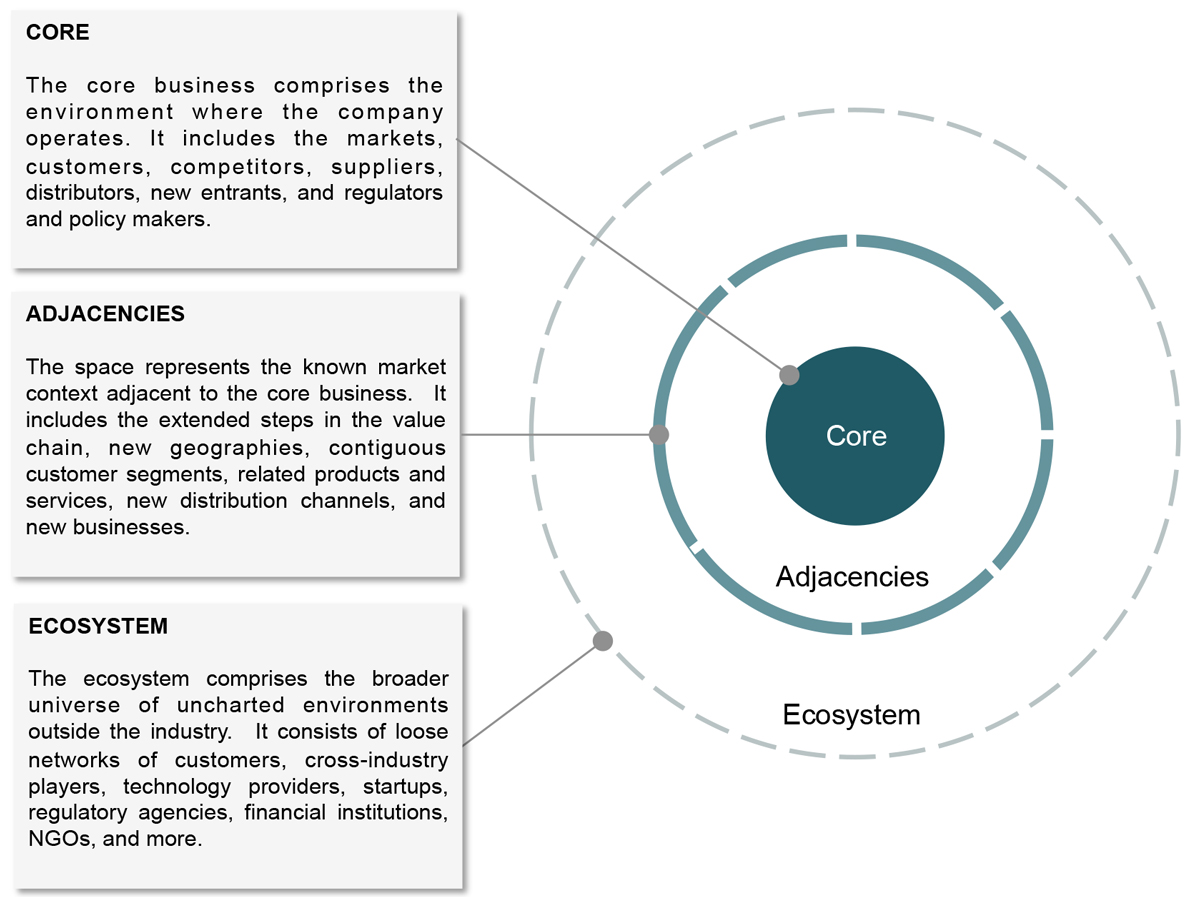THE CONTEXT
Three environments exist where companies can leverage growth: the core business, its adjacencies, and the ecosystem (Exhibit 1). Growth in the core consists of moves to increase revenue, including an increased share of spend, new customer acquisition, product or feature improvement, increased promotion, improved brand awareness, stronger reach through distribution, and price adjustments.
Growth in adjacent markets requires moving beyond the core business into known markets. It involves deploying existing assets in new markets, developing new products in current markets, changing the firm’s participation in the industry value chain (upstream, downstream), widening channels of distribution, or developing new businesses altogether.
EXHIBIT 1. THE THREE ENVIRONMENT OF GROWTH

Growth in the ecosystem takes venturing beyond industry boundaries into uncharted territories. Ecosystems form to create, scale, and serve markets in ways that are beyond the capacity of any single organization—or even any traditional industry alone. They are dynamic environments in constant co-evolution. In this space, leading companies collaborate to create new opportunities or address multi-industry challenges with new market-creating solutions. Growth in the ecosystem is long-term by definition and where the value is the greatest, given the considerable challenges it addresses (Exhibit 2).
EXHIBIT 2. THE HORIZONS OF GROWTH

BUSINESS ECOSYSTEMS
Business ecosystems come in all shapes and sizes that cannot be categorized in one type fits all. More importantly, however, they share a number of features:
- form to achieve objectives beyond the effective capability of a single actor
- serve extended communities to solve large fundamental issues
- exist on top of powerful technologies (business platforms)
- accelerate learning and innovation, and
- create extensive opportunities
Following are examples of different types business ecosystems that illustrate their value and diversity.
CAT® Connect links construction companies to Caterpillar for improved job-site efficiency. It collects equipment data from its network of connected customers’ equipment to monitor the state of the machinery. Caterpillar then uses this information to help customers increase productivity, improve equipment management, increase fuel efficiency, and safety.
This suite of services creates value for the company in several ways. It generates revenue with additional income from integrated data-based solutions, increased equipment sales, and after-market service. It also improves customer retention by offering the convenience of value-added data services, which raise switching costs.
Caterpillar partners with a few companies to bring its technology to market, including cloud storage, data analytics, connectivity, and fleet monitoring.
Source: Caterpillar
Honeywell INspire™ is an open, collaborative system that connects industrial plants across multiple industries to the company using the industrial internet of things (IIOT). The system addresses core industry problems, including production efficiency, process reliability, and supply-chain optimization, with gains otherwise not possible.
Honeywell derives value from the system by its position at the center of multiple industries. It generates revenue by aggregating data at various levels, including assets, processes, and plants. Also, it delivers analytic services and develops data services for its customers.
The Honeywell INspire™ program brings together thousands of partners in the form of collaborators, including technology companies, customers, equipment vendors, process licensors, consultants, working jointly with Honeywell experts.
Source: Honeywell
Maersk and IBM recently created TradeLens, a digital platform designed to empower businesses and authorities along the supply chain for more efficient and secure global trade. TradeLens comprises three components – network, platform, and an open market for applications & services. Each plays a distinct role in allowing members to advance their business.
The TradeLens network consists of ecosystem participants, such as ocean carriers, ports, inland transportation, and customs authorities, who connect to and provide data to the platform. TradeLens consolidates and secures the information and makes it available in the TradeLens platform, to anyone with permission to access it.
The TradeLens platform enables its members to take advantage of Blockchain data – track events related to shipments or seamlessly share documents with trading partners. Governed by an open system, the platform is delivered by the IBM cloud to members around the world.
An open market place allows TradeLens and third-parties to publish fit-for-purpose services atop the TradeLens platform.
The TradeLens ecosystem is starting to scale and comprises over 100 organizations, including carriers, ports, terminal operators, 3PLs, and freight forwarders. It also includes beneficial cargo owners (BCOs), insurance companies, and financial service providers from around the world.
Source: TradeLens
THE CHALLENGE
This ecosystem-based perspective has several implications for managers. First, a company needs to engage in the ecosystem to stay relevant. Why? Because every company is part of at least one business ecosystem, possibly more, and if it is not actively engaged, chances are its competitors are. Second, growth plans that only address the context of the company’s industry are likely to face severe shortcomings long term. Failure to grasp these realities may cause you to miss opportunities and underestimate threats.
CONCLUDING REMARKS
In a world of ecosystems, where industry boundaries soften, the company’s strategy requires a broad, long-term perspective. For a company to engage effectively in the ecosystem, two fundamental questions become immediately relevant in formulating its ecosystem strategy:
- Which ecosystem should we pursue?
- What role should the company play in the ecosystem?
Answers to these questions are far from obvious. For proper treatment, we explore these issues in their complexity in our next article, “Formulating an Ecosystem Strategy.”

